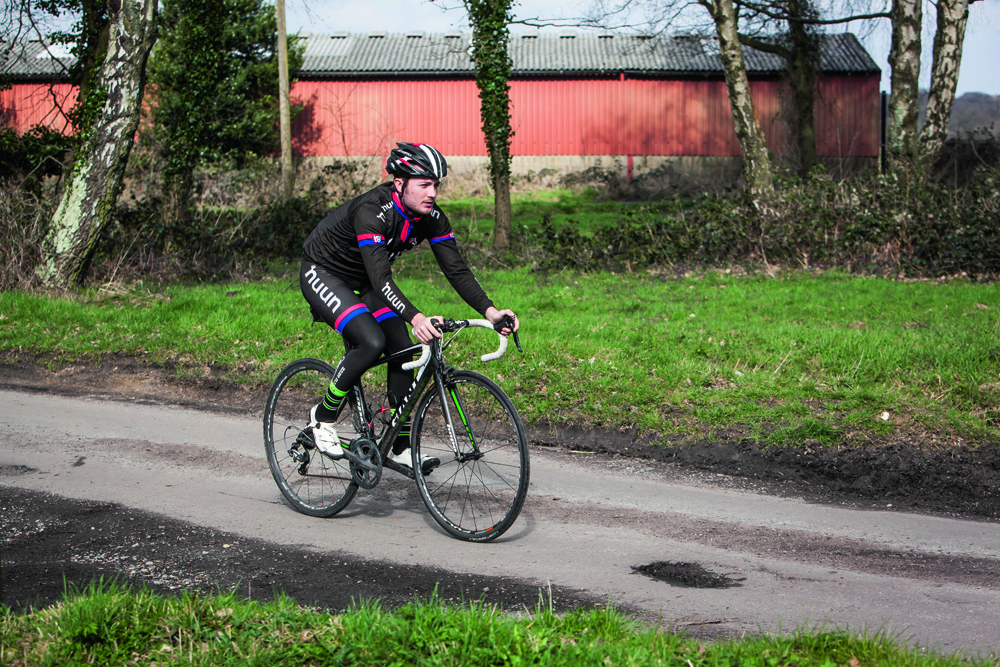Cyclists' guide to dealing with potholes
A couple of very poor winters coupled with a shortage of repair funds means potholes are everywhere. Here’s how to deal with them

According to published figures it will take £12 billion and 14 years to fix the backlog of road repairs and potholes on British roads, so, as cyclists, we have no choice but to accept they are a presence on the roads.
There’s a particularly nasty breed of pothole that looks like a mini sinkhole. Square edged and several inches deep, these holes will puncture, bend or even flip a wheel. Unlike shallower holes, which can just about be bumped over, these collapsed surfaces are to be avoided at all times.
Your mental approach is to habitually look up the road, scanning for dark patches and making smooth adjustments to your riding line in order to avoid potholes.
>>> Cobbles, potholes, and rough roads can cause nerve damage for cyclists, study finds
Daydream and you will be swerving around them, which is not good for you, your riding pals or other road users. On your regular rides, make a mental note of the potholes. If you ride in the dark, use a powerful front light and try to recce your route in the daylight beforehand.
Practice
Don’t be nervous about potholes; if you stay alert you can zap them with barely any effort at all. Remember, you only need to miss the edge by a few centimetres and it’s surprisingly easy to steer bikes accurately around small objects.
The latest race content, interviews, features, reviews and expert buying guides, direct to your inbox!
If you do ride into a normal pothole, relax the bars and lift yourself a little out of the saddle to unweight the bike and allow it to bump over the other side. Stay loose on the bike and absorb the impact through your arms and legs.

Don’t even think about riding into a nasty pothole. If it’s too late to swerve around it, and your feet are clipped in to the pedals, you can bunnyhop it by simultaneously pulling up on the bars and the pedals. Jerk them both at the same time and the bike will become airborne for just enough time to fly over the hole. Practice bunnyhopping on a straight piece of road or ground — it’s a simple and effective trick.
Also practice making little swerves on the bike. You will be surprised how late you can flick a bike around a pothole.
Equipment
Confidence in your machine is everything. The correct riding position, with arms slightly bent and ready to react, will get you through most pothole encounters. We’ve all felt the front wheel thump horribly into an unseen hole, only to pop out the other side with no more than a loud curse thanks to staying loose on the bike.
Keep the tyres pumped up. Underinflated tyres will pinch puncture on a pothole and could even damage the rim. You could even buy yourself a set of sturdy ‘winter training’ wheels to cope on unknown or particularly bad routes. And if you really can’t trust yourself to avoid potholes, ditch the road bike and get a mountain bike with a suspension fork.

Guide to tackling potholes on a bike
Think
Is this a newly laid tarmac surface or a heavily used, rough and un-maintained stretch? Can I go inside or outside that hole?
Eyes
Look forward of the bike and scan the road for changes in surface, anything that looks like a hole in ground.
Helmet
With the current state of the roads, even the best of us can get caught out. Wearing a helmet is never a bad idea.
Shoulders
Stay relaxed. If your shoulder feel like they are hunched up, make a conscious decision to drop them.
Elbows
Keep elbows bent and ready to react, as they should always be. Try riding along with arms straight, tensed and locked out — it’s much harder to steer or cushion yourself from the road.
Report that hole
Do the right thing for your fellow road users: if you spot a particularly nasty hole in the road, report it so that it gets fixed. Cycling UK's website www.fillthathole.org.uk enables you to report the location of a hole and the information is passed on to the relevant local authority.
Hands
Grip the bars, but not white knuckles. If you unexpectedly hit a pothole, it’s not good if one or both hands fly off the bars. Not good at all.
Tyres
Pumped to recommended pressures as indicated on the sidewalls. Fatter 23mm or 25mm road tyres will absorb bumps better than anything narrower. Mountain bike and hybrid tyres from 28mm can take big hits without puncturing.
Ride mates
If you’re riding in a group, especially if you’re near the front, be sure to point or call out any significant potholes — it could prevent a nasty spill.